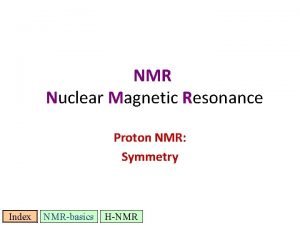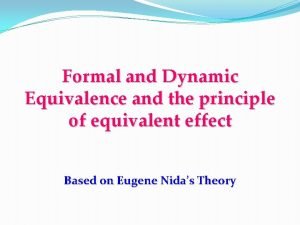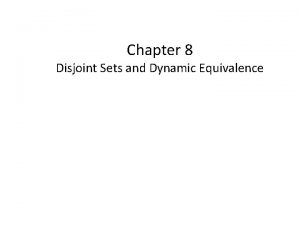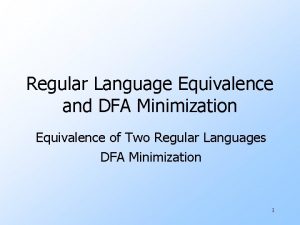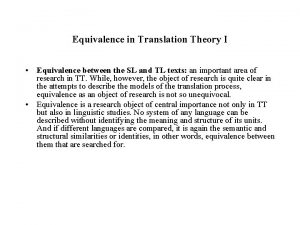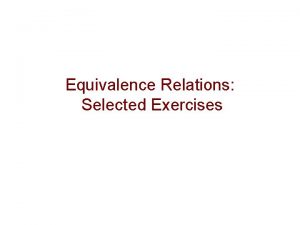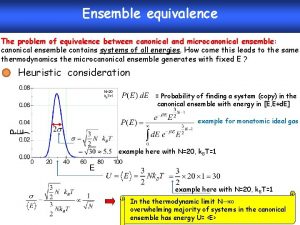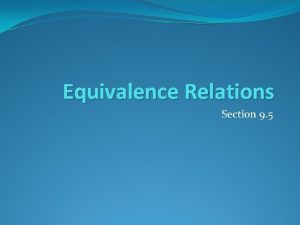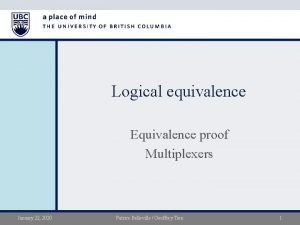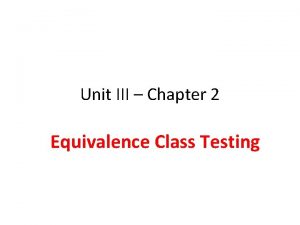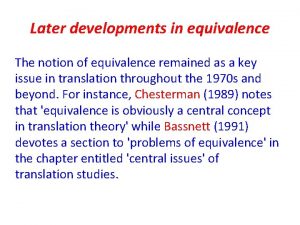The issues of Equivalence The issues of equivalence


















- Slides: 18

The issues of • Equivalence

The issues of equivalence • Equivalent – commensurate, comparable, correspondent, corresponding, equal, even, homologous interchangeable, similar, synonymous. • Equivalent – (1) something that has the same use or function as something else (2) equal in value, quantity, significance (3) having the same or a similar effect or meaning

The issues of equivalence • ‘sense for sense’< > ‘word for word’ • ‘free’ < > ‘faithful ▼ relationship between ST and the TT – how to define and measure ? tertium comparationis

Equivalent?

Is this text original?

Equivalence?

Roman Jakobson • Intralingual translation > rewording • Interlingual translation > ‘language to language’ • Intersemiotic translation > verbal into non-verbal Equivalence in difference – same message in two different codes. Languages differ essentially in what they must convey and not in what they may convey.

Equivalence in a formalist context • Vladimir Nabokov, ‘Problems of Translation: “Onegin” in English (in Venuti) • Vladimir Nabokov, ‘The Servile Path’ in • Evgenii Onegin or in R. A. Brower, On Translation (OUP, 1966)

Equivalence – early models • ‘… the text was seen as a linear sequence of units, and translation was merely a transcoding process involving the substitution of a sequence of equivalent units. ’ (M. Snell-Hornby, Translation Studies, p. 16)

Equivalence – early models • J. C. Catford – shifts, formal correspondence (See in Venuti)’ or his 1965 book (Library) • Vinay and Darbelnet • W. Koller – types of equivalence

Strategies and solutions Vinay, J. P. and J. Darbelnet, Comparative Stylistics. See in Venuti • • • Borrowing ( perestroika, tapas) Calques (fruits of the season, w czym mogę pomóc? ) Literal translation Transposition (rauchen verbotten > no smoking) Modulation (Vou l’avez échappé belle > You’ve had a narrow escape) • Equivalence • Adaptation • Areas affected by the above: the lexicon, syntax, the message

The science of translation – E. Nida • Formal equivalence – attention on message, correspondence (sentence to sentence, form to form), accuracy and correctness). • Dynamic eqivalence – relationship between a receptor and message should remain the same. • Lamb of God >>>> Seal of God • (See Nida in Venuti)

The science of translation – P. Newmark • ‘Communicative translation attempts to produce on its readers an effect as close as possible to that obtained on the readers of the original. Semantic translation attempts to render, as closely as possible the semantic structures and syntactic structures of the second language allow, the exact contextual meaning of the original. ’ (P. Newmark, Approaches to Translation) • Communicative – TL biased, idiomatic, free • Semantic – literal, faithful

The science of translation – A. Neubert • Translation is a text-induced text • The target text is textually different. It is ‘couched in a different world of discourse. ’ • Different communicative matrix • Source and target patterns of expectation.

Text Linguistics – A. Neubert • Last night the minister declared that the rumours about his resignation were totally unfounded. He was speaking at a dinner given by the Lord Mayor on the occasion of … • Gestern abend erklärte der Minister, daβ die Gerüchte über seinen Rücktritt jeder Grundlage entbehrten. Er machte diese Äuβerung während eines Essens, das der Oberbürgermeister aus Anlaβ… gab

Text linguistics – A. Neubert • Training in translation and interpreting, then, is training in awareness of intertextuality. Incidentally, this explains why one of the most effective training methods for students and practitioners of language mediation consists in textually-conscious reading and listening, particularly, of course in the target language, if it happens to be a foreign language. But, what is sometimes underestimated, training in awareness of textual conventions in one’s native language is just as helpful to achieve an advanced sense of intertextuality.

Semiotic equivalent • Word to image • Image to word • Image to image • Thomas, J. Reading Images. Palgrave 2001 • Kress, G. and Van Leeuven, T. Reading Images. Routledge 1996

Words-Images-Translation • www. visitwales. com
 Equivalence and equivalent effect in translation studies
Equivalence and equivalent effect in translation studies Diastereotopic protons
Diastereotopic protons Dynamic equivalence theory
Dynamic equivalence theory Các châu lục và đại dương trên thế giới
Các châu lục và đại dương trên thế giới Các loại đột biến cấu trúc nhiễm sắc thể
Các loại đột biến cấu trúc nhiễm sắc thể Thế nào là sự mỏi cơ
Thế nào là sự mỏi cơ Bổ thể
Bổ thể Phản ứng thế ankan
Phản ứng thế ankan Thiếu nhi thế giới liên hoan
Thiếu nhi thế giới liên hoan Alleluia hat len nguoi oi
Alleluia hat len nguoi oi điện thế nghỉ
điện thế nghỉ Fecboak
Fecboak Một số thể thơ truyền thống
Một số thể thơ truyền thống Sơ đồ cơ thể người
Sơ đồ cơ thể người Cong thức tính động năng
Cong thức tính động năng Số nguyên là gì
Số nguyên là gì đặc điểm cơ thể của người tối cổ
đặc điểm cơ thể của người tối cổ Tỉ lệ cơ thể trẻ em
Tỉ lệ cơ thể trẻ em Các châu lục và đại dương trên thế giới
Các châu lục và đại dương trên thế giới

